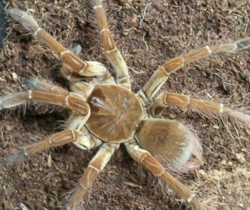Burgundy Goliath Bird Eater
 Scientific Species Name: Theraphosa stirmi
Scientific Species Name: Theraphosa stirmi
Ecological role: ground predator
Native habitat: tropical South America
Lifespan: 10 years or more
Maximum legspan: 10-11 inches
Life Cycle: Incomplete Metamorphosis
The Burgandy Bird Eater, along with other bird-eater tarantulas, is among the very largest type of spider on earth, with a legspan of up to about 11 inches. It is native to South America, but unlike most tarantulas, it does not live in dry areas. Instead, it inhabits swampy areas in northen Guyana.
Like all tarantulas, this bird eater is a predator, and it will eat almost any living prey that it can capture and kill, including mice, large insects, and lizards. Like its name says, it will eat birds. It probably cannot catch them very often, but it will eat baby birds, injured birds, and small flightless birds if it ever gets the chance. Bird eaters do not build extensive webs and they do not use webs to capture prey. Instead, they actively hunt for their prey. Tarantulas can produce silk, however, and they use it to line their burrows and to make their egg sacs. This bird eater can lay hundred of eggs in a single egg sac.
This Spider is Not Fully Grown
While our Chaco Golden Tarantula has reached its full adult size, this Burgandy Bird Eater is still a juvenile. Right now, it is about the same size as the Chaco, but it will eventually be almost twice as large. It will not reach full size for several years, so come back often to watch it grow!
Why is It Bald?
The Bird Eater's abdomen is partially bald because it often "flicks" the hairs off using its own legs. It does this whenever it feels startled or threatened. You can help to reduce this by not touching or tapping on the Bird Eater's cage.
What is Its Name?
In early 2013, the Explorium asked Facebook users to name this tarantula. They picked the name "Hercules," but since this is a female tarantula, her name is "Herculea"!
Is the Bird Eater Dangerous?
Tarantulas have very large venomous fangs (in large tarantulas like this one and the Chaco Golden, the fangs are the size and shape of cat-claws) and bites are painful, but the venom is only dangerous to people who experience severe allergic reactions to bites and stings. Like most tarantulas from the western hemisphere, this tarantula also possesses “urticating hairs.” These tiny hairs are a defense, and they can be “kicked” from the top of the tarantula’s abdomen. They can cause severe reactions in the eyes, respiratory system, and skin of predators (or people) who try to touch the tarantula.
Tarantulas in Kentucky?
Tarantulas do not live in Kentucky, but some of their close relatives do, including trap-door spiders and purseweb spiders. Kentucky is also home to many species of wolf spiders and fishing spiders--these aren't related to tarantulas, but they look very similar, and some of them are almost as big as tarantulas! Large tarantulas can be found as close as Missouri and Arkansas.
Even More About Tarantulas
Wikipedia: Tarantulas
Kentucky Spiders

